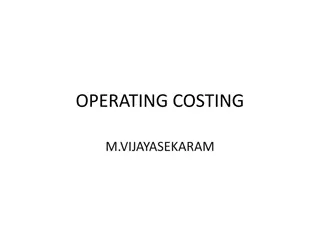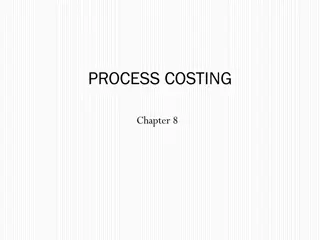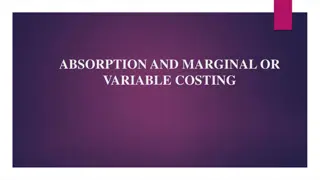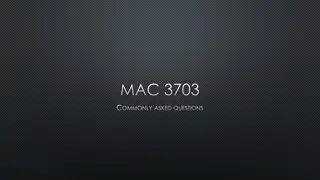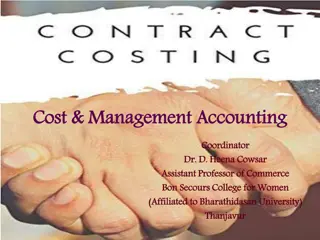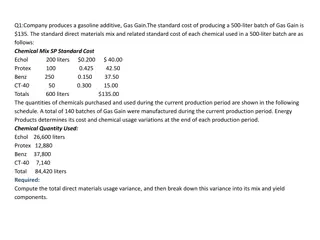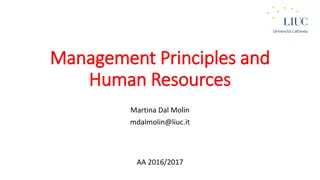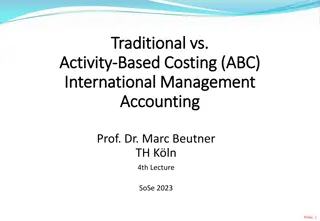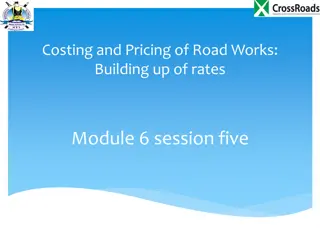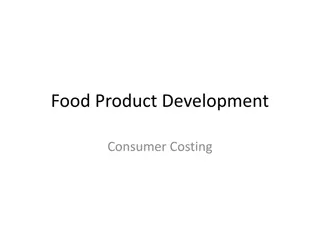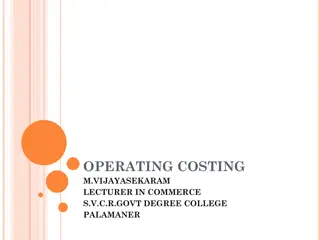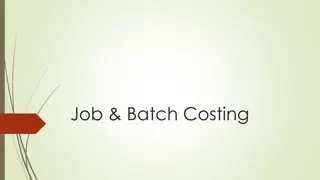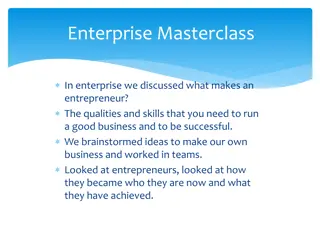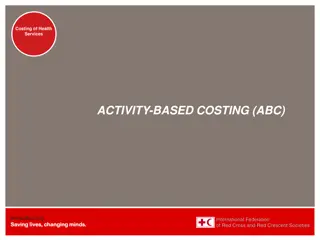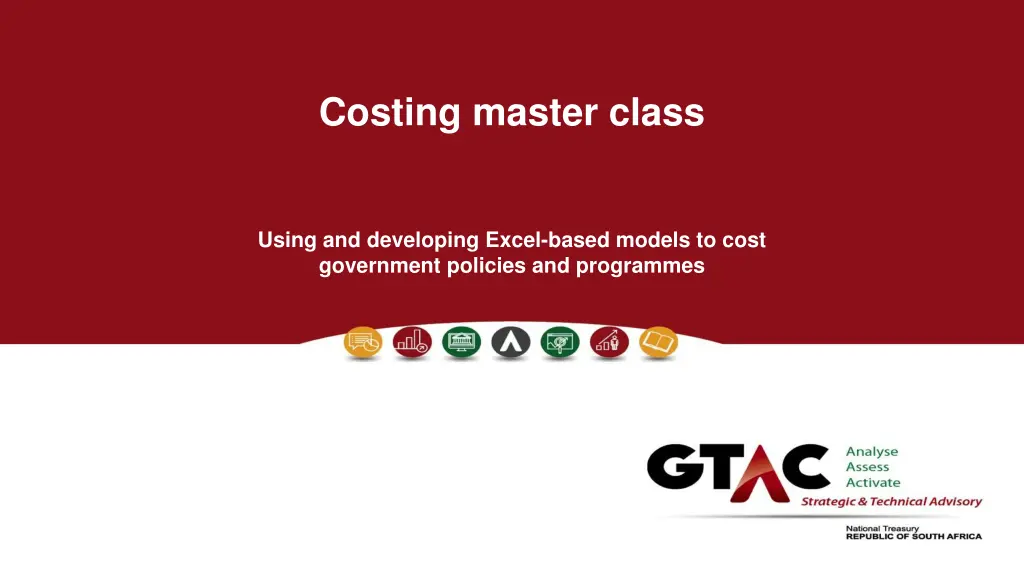
Excel-based Models for Costing Government Policies
Learn how to cost government policies and programs using Excel-based models in this comprehensive costing master class. Understand the principles of costing, steps in building a costing model, and explore the fiscal implications of policies to identify pragmatic options for sustainability.
Download Presentation

Please find below an Image/Link to download the presentation.
The content on the website is provided AS IS for your information and personal use only. It may not be sold, licensed, or shared on other websites without obtaining consent from the author. If you encounter any issues during the download, it is possible that the publisher has removed the file from their server.
You are allowed to download the files provided on this website for personal or commercial use, subject to the condition that they are used lawfully. All files are the property of their respective owners.
The content on the website is provided AS IS for your information and personal use only. It may not be sold, licensed, or shared on other websites without obtaining consent from the author.
E N D
Presentation Transcript
Costing master class Using and developing Excel-based models to cost government policies and programmes
Agenda Introductions and objectives of the masterclass Presentation - (Q&A at any time) Preparing to build a costing model Costing formula Principles of costing Steps in building a costing model Body break 12:30 12.35 Demonstration of the ECD Model Closure 2
Preparing to use / build a costing model Market prices Actual service delivery Costing model Processes, activities and inputs Non-government funding Programme logic analysis Expenditure analysis Norms and Standards Price Govt price standards Regulations Institutional structure Govt Accounts Demand Expenditure reports Legislation Institutional analysis Key performance indicators Key policy questions ? Performance information Policy Demographic and Administrative Data Powers and Functions Assigned (usually in a Constitution) 4
Whats in a costing model? Costing is the process of using the following equation to estimate total programme costs = x x Cost Input Price Quantity This equation is used in many different forms to estimate the cost of many layers and types of activities 5
Costing brings fiscal realities into policy discussions Policy often reflects ambitious, idealistic best practice scope of the policy norms and standards coverage of intended beneficiaries objectives are laudable, but not fiscally affordable or sustainable A costing model explores the fiscal implications of policy identify pragmatic options that are more affordable and sustainable. moderating the scope of the policy reducing the norms and standards from best to good practice restricting the eligible beneficiaries to those most in need construct the costing model so that the implications of these changes can be explored 6
PRINCIPLES FOR EVALUATING AND BUILDING COSTING MODELS 7
Balancing the art and science of costing 80/20 principle too much detail is a bad thing! Transparency show all assumptions and calculations Formatting principle keep it simple and be consistent Ordering principle arrange the worksheets logically Colouring-in principle use colours to identify cells KISS principle keep it (all parts of the model) simple Principles for building costing models Apply these principles from the very beginning it saves a lot of time! 8
Balancing the art and science of costing Always keep in mind that Building a good costing model is Building a good costing model is a blend of both art and science a blend of both art and science One is objective and the other subjective The science dimension involves data, formulas and math The calculations are either right or wrong The art dimension involves imagination, assumptions and judgement Does the design of the model adequately reflect reality? Are the key assumptions reasonable, realistic and informed? Getting the balance right requires judgement - strengthened by experience 9
80/20 principle Too much detail is a bad thing! focus on the 20% of cost components which account for 80% of the costs focus on getting 80% of the costs by doing 20% of the costing work How does one avoid too much detail? Focus on identifying the key cost drivers - the main programme elements and activities the key groups of clients or beneficiaries of the service the main inputs, activities and outputs of the service Avoid trying to work out How long is a piece of string? simply make an informed assumption or identify a plausible range 10
Transparency Show all assumptions and calculations avoid using hidden sheets, hidden cells or hidden formulae Avoid building assumptions into the formulae Wrong if: Administrators (level 8) : 26 = (D82*9)+D83 Right if: 26 =IF($C$1=$U$14,(D82*9)+D83,D82+D83) Can you explain the difference? Use the notes function to provide explanations 11
Formatting principle Keep formatting simple and be consistent structure similar sheets the same way data sheets, working sheets, results sheets avoid blank columns or rows when working with series data makes it more difficult to drag or copy & paste formulae summary data should be structured in exactly the same way on each sheet - identical cell references this facilitates the consolidation / adding-up of information Provincial Management Total Provincial Management Cost of employment Operational costs Payments for capital assets Total ProvincesPragmatic Scenario 2014/15 R 160 331 064 R 1 407 090 373 R 8 016 553 R 1 575 437 991 Total operating costs 12 Total infrastructure costs (once-off) R 702 000 000
Ordering principle Arrange the worksheets logically contents and descriptions, result sheets, working sheets, data colour the sheet Tabs to distinguish different kinds of sheets Costing Model Setup and Analysis Sheets Output Sheets Main Costing Sheets Working Information Sheets MSetup Startup USDSum_ExR PDiagram Management USDSum_PPP PElements Training Sum DeliveryV GroupV Amortization HomeV ExRates CTransfers PPP Template1 Inflation Template2 Definitions Template3 Lists Buildings 13
Colouring-in principle Use colours to identify different types of cells information cells descriptions of inputs or assumptions number input cells where number assumptions are inputted formula cells where the results of formulae are shown clear / white light blue light yellow Changing assumptions As a general rule: if a number is in a blue cell then it is a variable that can be changed by the user. These cells contain conditional formatting that results in them being highlighted green if the user changes the variable. This is to allow for easy tracking of scenario changes. If a number is in a yellow cell then it is a calculated amount based on the assumptions in the blue cells. The yellow cells must not be 'over-typed' as they contain formulae (this will not be possible so long as the locked status of the spread sheets it maintained). 14
KISS principle Keep it (all parts of the model) simple Show calculations in steps rather than using long formula Use sheets to separate different types of data/information Use the Group function to make it easier to navigate 15
Balancing Art and Science KISS principle 80/20 principle building a good Costing Model Colouring-in principle Transparency principle Ordering principle Formatting principle Apply these principles from the very beginning it saves a lot of time! 16
Questions or comments? 17
1. Discuss why you have not simply been given a costing model template (like the budget format template) for costing government programmes? Why can t we simply use a costing model template? 2. Within the context of building costing models, discuss what is meant by form follows function ? 3. What do you think the advantages and disadvantages are of building a unique costing model for each new costing project? 19
Build formulae Policy choices Preparation Design Specify Summarise Check Steps in building a costing model Step 1 Preparation Step 2 High level design of the costing model Step 3 Specify activities, demand and inputs Step 4 Build the costing formulae Step 5 Summarise the costing results Step 6 Check, check, check Step 7 Develop the policy choices sheet The process is very often not linear, and one finds oneself having to go back to previous steps Building a costing model is a learning process 20
Step 1 - Preparation Preparation Are all the prerequisites in place? Have you done the background research? Have you gathered the data you require? Do you have a really good understanding of the programme? Process map / flow chart of programme (covered in Module 1) The logical framework (covered in Module 2) The norms and standards (covered in Module 3) If clear norms and standards do not exist, then you will need to develop your own set, which become variables in the model The expenditure analysis (covered in Module 4) Do you know what policy questions you need to answer? 21
Understand the institutional context of programme delivery Costing models need to be structured to reflect the institutional environment So the costing model may need to calculate costs by: sphere of government, individual province or municipality, different national and provincial departments, public entities, non-governmental organisations, and sometimes even private sector entities and individuals. 22
Keep focussed on the key policy questions Keep asking yourself: What are the key policy questions that this model should be able to answer? Then design the model so that it can be used to ask and answer those questions quickly and easily develop short-cut methods of asking and answering e.g. toggling a few buttons/numbers on one sheet set this up in a front policy choices sheet use graphs (that are simple) to present answers Policy-makers want answers to a limited number of questions the trick is to answer each question in the way it is asked 23
Example: In nutrition programmes you want pregnant women to take folic acid before, during pregnancy and also while they are breastfeeding. Politicians may want to ask: 1. What is the impact of increasing/decreasing expenditure on this intervention by 20%? How many more/fewer pregnant women will benefit from this intervention? 2. What is the impact on the budget of expanding the intervention from all pregnant and breastfeeding women to all women in the reproductive age group? Each of these questions requires a different model It helps a to know which questions politicians are likely to ask and therefore whether you need to develop one or two models. Why does the way the question is asked matter? 24
Balance key policy questions against core information A costing model must answer the key policy questions Since these differ, the design of each costing model will differ Still, all models should show: capital versus operating costs set-up versus ongoing costs especially for new initiatives personnel costs disaggregated by function of employee e.g. show nurse and doctor salaries separately the cost of key inputs different medicines in health textbooks vs classroom consumable in education transport vs food vs salary costs in a feeding scheme 25
Step 2 High level design of the Costing Model Design Develop the overall structure of the workbook Identify what worksheets you need and name them Develop sensible tab names (not numbers or letters) Colour the tabs for sheets with data, workings and results Will you require a GenAssumptions sheet? Design the overall structure of the different kinds of sheets Headings and sections Scenarios Costing results, and summaries of costing results Demand assumptions Activity assumptions inputs and prices Start colouring-in the cells Insert the data sets you will be using 26
Deciding on the structure of scenarios Nature of the programme and the time parameters of the costing influence how one approaches scenarios As a minimum, provide for costs over an MTEF period Proposed scenarios (choosing appropriate names is important) baseline or current existing levels of service full cost complete implementation of the policy pragmatic proposed costing saving policy options rollout different rollout options Design model structure so that new scenarios can be added For some programmes it is better not to include scenarios: it would make the model too complicated better to run scenarios on different copies of the model 27
Examples of scenario naming Scenarios in the INSET Costing Model SUMMARY Pragmatic Scenario Scenario 1 (with MTEF) Scenario 2 2014/15 R 669 907 526 Policy Scenario 2014/15 R 884 544 141 2014/15 2014/15 2015/16 R 105 675 519 2016/17 R 233 173 023 Additional cost relative to the Pragmatic scenario - operations R - Additional cost relative to the Pragmatic scenario - infrastructure R - R 51 624 000 R 104 863 296 R - R - Scenarios in the MAFISA Costing Model Total Cost over five year agreement SUMMARY OF MAFISA MANAGEMENT COSTS Scenario of Agreements with Financial Intermediaries Year 1 Year 2 Year 3 Year 4 Year 5 D1. Financial intermediary costs: NERPO Income from MAFISA loan Expenses of managing MAFISA loan Interest payment on loan capital Losses from bad debts Profit/Loss from MAFISA R 920 000 R 1 028 001 R 115 000 R 831 067 R -1 054 068 R 2 946 667 R 1 803 954 R 368 333 R 2 712 933 R -1 938 554 R 3 245 867 R 1 246 546 R 405 733 R 3 099 211 R -1 505 623 R 4 081 440 R 1 811 388 R 510 180 R 3 878 367 R -2 118 495 R 4 735 387 R 1 232 105 R 591 923 R 4 517 144 R -1 605 785 R 15 929 360 R 7 121 994 R 1 991 170 R 15 038 722 R -8 222 526 Scenarios in the Nutrition Costing Model Select province or the whole country South Africa Scenario 1 (with MTEF) Scenario 2 2015/16 R 2 525 317 715 R 7 745 046 262 R 30 434 616 R 10 300 798 594 Scenario 3 2015/16 R 3 509 444 696 R 9 635 976 407 R 30 434 616 R 13 175 855 719 budget choices 2015/16 R 4 860 680 276 R 8 865 332 148 R 30 434 616 R 13 756 447 040 2015/16 R 5 417 212 198 R 9 271 829 627 R 30 434 616 R 14 719 476 441 2016/17 R 5 903 776 066 R 9 781 200 919 R 32 273 481 R 15 717 250 466 2017/18 R 6 281 337 547 R 10 307 422 704 R 34 224 202 R 16 622 984 452 Health Social Development Agriculture 28
Step 3 Specify activities, demand variables and inputs Specify Organise the activities you are going to cost on the workings sheets List the demand variables and key input variables Personnel, time variables, price variables Keep variables that belong together close together This involves thinking through each activity Start colouring-in the cells Identify variables that should be placed on the GenAssumptions sheet Keep the design structure aligned across sheets so you can use the drag / copy and paste functions 29
Build formulae Step 4 Build the costing formulae If the structural design of your model is good, it greatly facilitates the building of costing formulae column and row references exactly the same demand data structured the same as input and price data Apply the formula: Work systematically, accurately and don t rush Apply the KISS principle When building the formulae you will likely find that you require more demand variables, different input variables etc. Change things in a systematic way 30
Step 5 Summarise the costing results Summarise In design step Specify where the costing results will be summarised What kinds of summaries you will require? Summarise costs overall total costs showing set-up, ongoing costs and capital totals by type of key inputs and other totals by main activity / type of institution totals by sphere of government, by province, by municipality Summaries of outputs by activity Summaries of personnel and key inputs Explore options for unit cost and marginal cost calculations 31
Create a flow diagram of your model Develop a flow diagram to show: the structure and the logic of the model place this in front of the model Gives a snapshot of where the various components are Costing Model Setup and Analysis Sheets Output Sheets Main Costing Sheets Working Information Sheets MSetup Startup USDSum_ExR PDiagram Management USDSum_PPP PElements Training Sum DeliveryV GroupV Amortization HomeV ExRates CTransfers PPP Template1 Inflation Template2 Definitions Template3 Lists Buildings 32
Step 6 Check, check, check Check Use different approaches to summarise costing totals SUMIF and straight adding Check for consistency across different costing summaries input cost totals = activity cost totals Test if the model is robust do back of the envelope type calculations to check whether costing results are of the right order of magnitude run extreme scenarios on key demand and input variables and check if the model behaves as expected run incremental scenarios (25, 50, 75%) and check if the results are consistent be aware of the impact of fixed costs versus variable costs Get a new set of eyes to go through the costing model present the costing model to subject experts 33
Policy choices Step 7 Develop the policy choices sheet What are the main policy questions? aim to provide answers that reflect how the question is asked Develop a dynamic policy choices sheet where the implications of different options can be explored Keep the options simple and realistic use dropdown options, toggle buttons or simple input cells to specify different options Illustrate the results of different options using simple graphs Reflect options in relation to a baseline a current funding baseline or a baseline scenario 34
Technical tips - 1 Learn how to use the following Excel functions: INDEX MATCH V/HLOOKUP IF SUMIF SUMPRODUCT Drop down menus (Data validation/Lists) Group function Think about the above when ideas swirl in your head Conditional formatting has its merits, but keep it simple 36
Technical tips - 2 Keep the design structure aligned across sheets so you can use shortcut drag / copy and paste functions Avoid macros not enough people understand how to use them Avoid using cell names (named cells) they reduce the transparency and traceability of formulae they create problems when sheets are copied into a workbook 37
Questions or comments? 38
GTAC Government Technical Advisory Centre Private Bag X115 Pretoria 0001 GTAC Government Technical Advisory Centre 240 Madiba Street Pretoria 0002 info@gtac.gov.za www.gtac.gov.za 39



